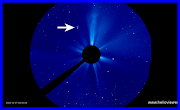The biggest star in the universe is a matter of debate and depends on how one defines "biggest."
Stars come in various sizes, and their classification can be based on different criteria such as mass, volume, or luminosity.
In terms of mass, some of the largest known stars include red supergiants and hypergiants. Here are a couple of examples:
UY Scuti: UY Scuti is often cited as one of the largest known stars by radius.
It is a red supergiant located in the constellation Scutum. Its estimated radius is around 1,700 times that of the Sun.
However, it's important to note that these estimates can have some uncertainty.
The size of stars can vary significantly during their lifecycle. UY Scuti, as a red supergiant, is in a late stage of its evolution, having expanded greatly compared to its earlier life as a smaller main-sequence star.
Ultimately, these supergiant stars, including UY Scuti, will end their lives in dramatic supernova explosions, casting off their outer layers into space and leaving behind a compact remnant, such as a neutron star or black hole.
Betelgeuse: Betelgeuse, located in the constellation Orion, is another massive star and a well-known red supergiant. It has a radius estimated to be over 900 times that of the Sun.
While UY Scuti and Betelgeuse are among the largest stars known by radius, there may be even more massive stars yet to be discovered.
The study of stars is ongoing, and astronomers continue to search for and learn about these massive celestial objects.
It's essential to recognize that when discussing the "biggest" stars, different criteria can yield different results.
For example, some stars may be more massive but less voluminous than others.
Additionally, the classification of stars can change over time as our understanding of the universe evolves and as new stars are discovered and studied.

















